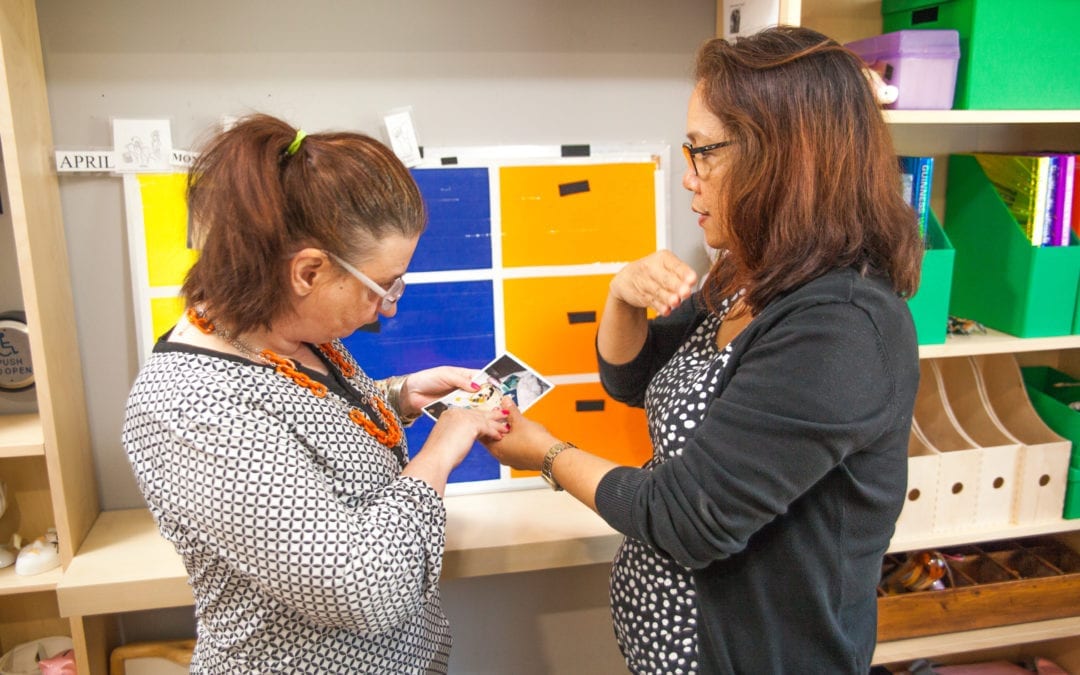Each individual with deafblindness has a unique experience interacting with the world and communicating with others. DeafBlind Ontario Services is committed to ensuring that each person at the organization has the ability and opportunity towards expressing themselves in a communication plan that best suits their experience of navigating the world with dual sensory loss. A communication plan sets an individual up for success as it allows them to have a voice in what they do throughout their day, as well as any future commitments.
Over 1% of Canada’s population or approximately 466,420 people are deafblind. In Ontario, an estimated 211,250 individuals are deafblind. Taking into consideration that 95% of what we learn comes from what we see and hear, emphasizes the importance of communication methods used with those that experience hearing and vision loss.
Professional intervenors empower people with deafblindness to thrive and succeed. By facilitating the exchange of information through their own unique individual way of communicating – such as through tactile symbols, objects of reference, various forms of sign language or braille, leads to a better sense of social connectedness in their daily lives and within the community.
“The most important thing I have learned is total-communication is incredibly important and it is specific to every person,” explains Katrina Paddley.
Katrina is a Client Service Advocate and has been working at DeafBlind Ontario for 8 years. Her knowledge of communication methods is extensive as she works with six different calendar systems. A Client Service Advocate holds a very important role within the organization. This position is responsible for the development, training and mentorship of intervenors within their designated region. They hold skills that show passion, coordination and dedication that allow for the creative planning of tasks such as calendar systems.
A calendar system is specific and based on the needs and abilities of each individual. Calendars come in many forms and use a Total Communication Approach (TCA). TCA uses tactile, pictorial and physical cues in conjunction with speech, signs and gestures for an effective communication strategy for each individual.
Cues are a form of receptive communication, as they signal to an individual what will happen in the present or future. The cues that are learned are a helpful tool for anticipation, planning and choice. There are various examples of cues that can be used to describe activities, involvement or upcoming events. Katrina explains all of the ways the activity of baking can be represented.
This meaningful cue for each individual can be very different. For example, some individuals know that their blue spatula is a concrete cue for “bake”. Some have a photo of a cook book (a picture cue) and others have scented cinnamon playdoh patties in a container (scent cue). Baking is just one example of an activity, however, options are endless, specific and continue to work with everyone’s individual communication style and calendar system.
Calendar systems have the ability to represent the needs and abilities of each individual. By having this system it gives a sense of independence, as it lets individuals have the power of choice to plan out their day or future endeavours that fit well with the cues they have learned.
DeafBlind Ontario Services values and prioritizes fostering independence for every individual they support. “It is so normal for us to understand what we do each day, the calendar system provides a structure that utilizes success and regulates what someone can do. It minimizes a negative system that makes one lose their own sense of independence,” says Katrina.
Effective and specific communication methods are an integral part of DeafBlind Ontario Services service model. As each individual is unique, it is important to understand that they too have various and comfortable communication methods that allow them to live a fulfilling life.




Recent Comments